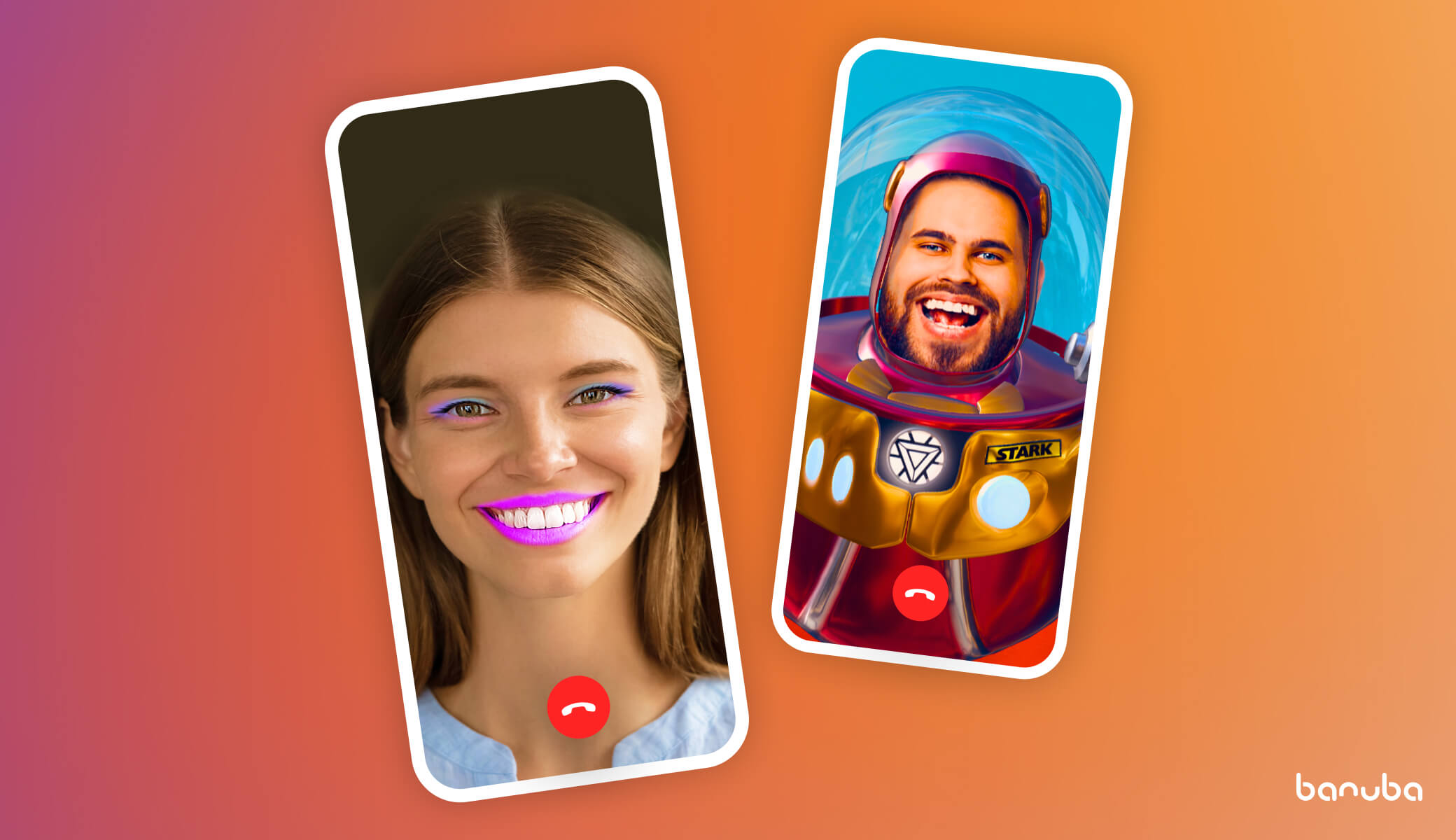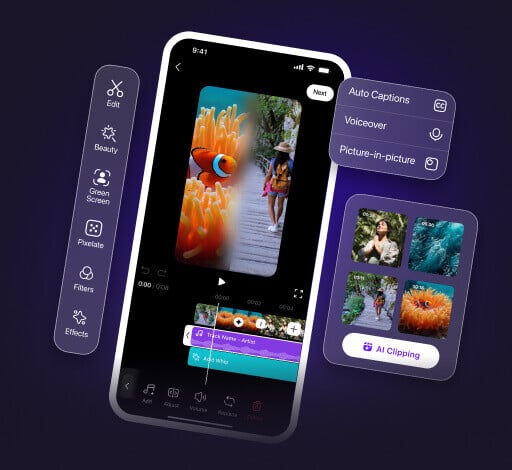Top 8 Video Editing SDKs & APIs in 2025
We have compared top 8 video editing SDKs & APIs on the market, as choosing the right one can be tough.
We decided to make your life easier by featuring:
- 8 best mobile video editing SDKs
- 5 key criteria you should consider
- Feature-by-feature comparison of top video editor SDKs.
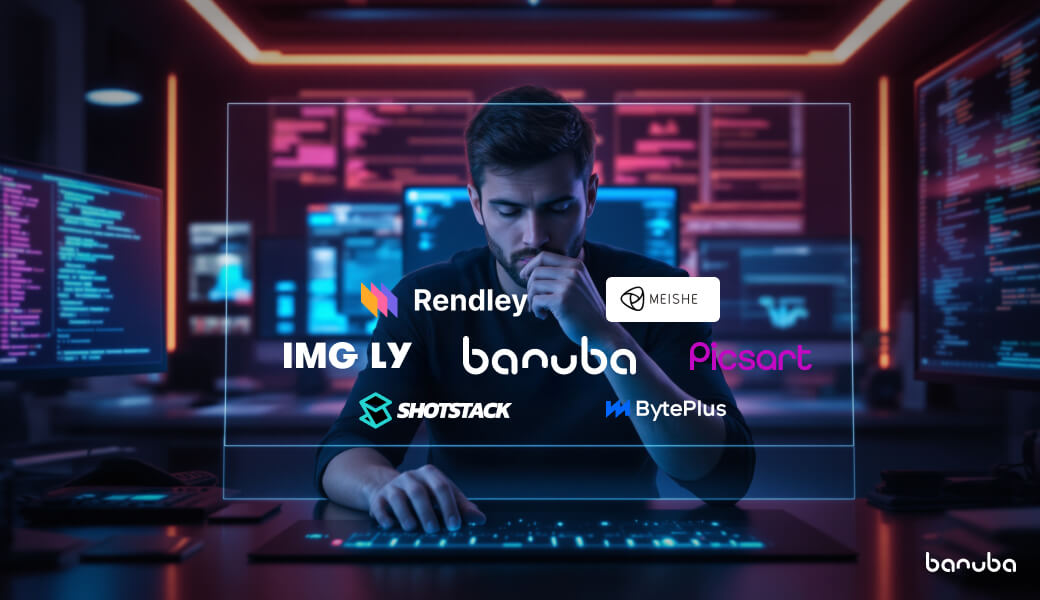
[navigation]
8 Best Video Editing SDKs & APIs
1. Banuba Video Editor SDK
Banuba Video Editor SDK is an all-in-one solution for mobile video editing. On the one hand, it includes everything your users need to trim and recut their footage. On the other hand, it offers a huge variety of filters and effects to enhance the content. It even includes AI-based tools to automate video creation and editing. At the same time, Banuba Video Editor SDK only adds about 25 Mb to the app’s download size, is easy to work with
Feature set:
- Recording
- Trimming/merging
- Timeline
- Audio editing
- Royalty-free music library
- Music provider integration
- 2D and 3D masks
- Color filters
- Background replacement
- Picture-in-picture mode
- Freehand drawing
- Templates
- AI clipping
- AI subtitles
- Lip syncing
- Lip sync video generation
- Video generation from photo
- Etc.
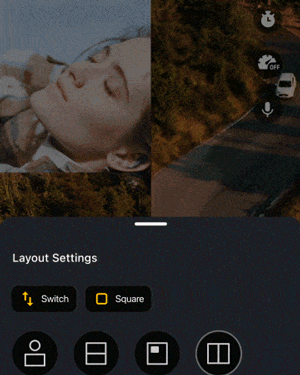
Platform support:
Banuba Video Editor SDK is available for native Android and iOS, as well as React Native and Flutter. It also has a so-called API version that offers fewer features out-of-the-box, but has no limitations on what can be customized.
Integration:
Integrating this SDK is quick and easy, sometimes taking less than 8 minutes.
Pricing:
The pricing of Video Editor SDK is flexible, and depends on the number of platforms you want to support, the number of monthly active users, and the specific feature set. As a result, it is affordable even to mid-sized companies and startups. In addition, there is a 14-day free trial where prospective customers can evaluate the entire SDK and see how it fits their needs.
Typical use cases:
Social media (Press Sports, Weat), photo/video editing apps (Videoshop), eCommerce, eLearning, Marketing.
Key takeaway:
A flexible and feature-rich video editing SDK for mid-sized and larger companies.
2. Meishe (Meicam) SDK
Meicam has been on the market for many years, and gained a large customer base, especially in Asia. It focuses on the popular short video format, providing a comprehensive suite of features for making TikTok-like content.
Feature set:
- Recording
- Trimming/merging
- 2D and 3D masks
- Color filters
- Timeline
- Virtual makeup
- Beauty filters
- AI editing
- Smart composition
- Etc.
Platform support:
Meicam SDK has versions for Android, iOS, HarmonyOS, React Native, Flutter, Web, and desktop platforms.

Integration:
Due to its coding approach and complicated documentation, using the Meicam SDK is more difficult than many other entries on this list.
Pricing:
Meishe doesn’t disclose its license costs or even what influences the price.
Typical use cases:
Broadcasting, eLearning, social meia, automotive.
How it compares to Banuba:
These SDKs are more or less equal to each other, though Banuba is much easier to work with. There are also some differences in specific niches. For example, Meishe supports HarmonyOS and offers noise suppression, while Banuba has AI video generation and a royalty-free music library. See a Banuba vs Meishe comparison page for the details.
Key takeaway:
A solid choice for a larger company with an in-house development team.
3. IMG.LY
Img.ly Video Editor SDK is one of the market-leading tools. It is designed to be friendly to both users and developers, which is why many leading companies favor it over its competition.
Feature set:
- Recording
- Trimming/merging
- Video collage
- Brush
- Blur
- Color filters
- 2D stickers
- Frame effects
- Audio editing
- Asset library
- Captions
- Etc.

Platform support:
Img.ly supports native Android and iOS, as well as Flutter and React Native.
Integration:
Simple integration process and a detailed documentation to support it.
Pricing:
Img.ly has pricing tiers based on the number of monthly active users and the number of exported videos. It can fit the budget of both startups and established enterprises.
Typical use cases:
Social media, eCommerce, photo/video editing, marketing, cloud storage.
How it compares to Banuba:
Img.ly is just as easy to work with and is also affordable. However, Banuba has many more features, including killer ones like AI clipping or video generation. In tests, img.ly has also shown to be slower when exporting videos. See the one-to-one comparison table for details.
Key takeaway:
A reliable and scalable product for the companies focused on core video editing.
4. Rendley
Rendley is a promising newcomer to the market. It differs from the other products, because it is browser-based. Which means compatibility with a wide range of devices and easy installation at the cost of performance.
Feature set:
- Trimming/merging
- Cropping
- Color filters
- Transition effects
- Captions
- Animations
- After Effects compositions import

Platform support:
Rendley runs in the browser, so anything that has a web browser can run it. However, this also means lower performance, especially when processing higher-quality videos.
Integration:
Simple and low-code. The documentation covers all the bases.
Pricing:
Hidden. Rendley shares neither the license cost nor its components, so you’ll have to contact them if you are interested.
Typical use cases:
Video players, photo/video editing apps, social media.
How it compares to Banuba:
Banuba’s SDK is much more mature, used by more customers, and has a much larger feature set. Rendley also has no UI, which means unlimited customization, but also additional work.
Key takeaway:
A convenient SDK with a low entry barrier, designed for startups and small teams.
5. Shotstack
Shotstack is a cloud-based AI video editor. It is oriented towards companies that need to make a lot of videos quickly, so the developers made an effort to automate as much of it as possible.
Features:
- Trimming/merging
- Timeline
- Captions
- Color filters
- Templates
- Transitions
- HTML text styling
- AI video generation
- Thumbnail generation
- Etc.

Platform support:
Shotstack is a cloud-based API, so a desktop, web, or mobile application can access its features regardless of the language it’s written in. However, it only works when there is internet connection.
Integration:
Simple and well-documented API access makes Shotstack easy to integrate.
Pricing:
Customers can either choose a pay-as-you-go model at USD 0.30/minute, purchasing enough “credits” for their needs. The second option is to get a subscription at USD 0.20/minute. There is also a custom plan for clients that need to generate and edit a lot of footage.
Typical use cases:
Large corporations, marketing, social media, eCommerce.
How it compares to Banuba:
Banuba Video Editor SDK in all its versions is built into the app and runs on the user’s device. This means it can work offline and doesn’t transfer any user data. Shotstack has to have internet connection to run, and has to send data to the cloud servers, which is a potential vulnerability.
Key takeaway:
A great tool for professionals to generate a lot of content, but not so convenient for casual users.
6. Very SDK
Very SDK is a reliable choice for any company that needs to speed up the development of their app and provide users with a lot of video editing features. With a clean UI and a ton of options, it does what it claims to do.
Features:
- Recording
- Trimming/Merging
- Video collage
- Picture-in-picture
- Music editing
- Subtitles
- Color filters
- Templates
- Face editing
- Beauty effects
- Etc.
Platform support:
Very SDK is designed only for native Android and iOS, so if you want to use cross-platform frameworks, look elsewhere.

Integration:
Relatively simple, based on the user reviews. The documentation is not public, so judging its quality is hard.
Pricing:
Very SDK has two license tiers. The Pro plan costs USD 10.000 per year per platform, and the Deluxe one costs USD 20.000 . Each license is priced per platform, which means you need to buy two if you want to release your app on both Android and iOS.
Typical use cases:
Social media, video/photo editing apps, eCommerce, eLearning.
How it compares to Banuba:
Banuba supports Flutter and React Native, allowing developers to benefit from everything cross-platform frameworks bring to the table. It also has features like AI clipping, video generation, and AI subtitles, which Very SDK doesn’t have.
Key takeaway:
A quality video editing SDK, though not the most advanced out there.
7. Tencent UGSV
UGSV stands for “user-generated short videos,” underscoring that this SDK is a dedicated solution for modern social media content. It is developed and distributed by the Chinese tech giant Tencent, which can be a benefit (a large and skilled development team behind it is an asset) or a drawback, as in some locations it is at the risk of government sanctions.
Features:
- Recording
- Trimming/merging
- Stickers
- Virtual backgrounds
- Templates
- Beauty filters
- Watermarks
- Clipping
- Face editing
- Etc.

Platform support:
Native Android and iOS, covered by extensive and detailed documentation.
Integration:
Relatively simple, although it requires more steps (e.g.getting a TencentCloud API key) than some others.
Typical use cases:
Social media, broadcasting, consulting, gaming.
Pricing:
Tencent UGSV has several pricing plans ranging from USD 1,899 to USD 79,999 per year. A single license applies to a single app, but covers both Android and iOS. The plans themselves differ in the features they cover.
How it compares to Banuba:
Besides supporting only native mobile technologies, Tencent UGSV lacks AI editing capabilities that Banuba offers. However, it has useful niche tools like automatic nudity detection.
Key Takeaway:
An enterprise-grade SDK that covers core editing use cases and a few specific ones.
8. Picsart
Picsart combines photo and video editing capabilities in one SDK. It is embeddable, designed to integrate into a website or a web application.
Features:
- Trimming/merging
- Crop
- Resize
- Transitions
- Captions
- Stock photo library
- Color filters
- Background removal
- Animations
- Erase
- Etc.

Platform support:
Picsart is designed to be used as a part of a website or a web application. In addition, it doesn’t work on mobile devices, which limits its functionality for casual users.
Integration:
Simple, low-code integration. The process is short and well-documented.
Typical use cases:
Print-on-demand, social media, eCommerce, marketing.
Pricing:
To access Picsart’s video editor, you will need to spend at least USD 299/mo. There is also an enterprise plan which requires prior discussion and negotiation with the vendor’s team.
How it compares to Banuba:
An apples-to-oranges comparison, as Banuba is focused on mobile platforms, while Picsart is entirely web-based.
Key takeaway:
An easily-integrated SDK for companies who don’t need to cover iOS and Android users.
5 Criteria to Consider When Choosing a Video Editor SDK
We are going to compare mobile video editor SDKs by 5 major aspects:
- Video editing functionality: trimming, subtitles, templates, etc.
- Camera features: zoom, flash, hands-free mode, etc.
- Effects. AR masks, background replacement, etc.
- Technical parameters: support for cross-platform frameworks, AR cloud, etc.
- Commercial parameters: price and pricing options, support response speed, trial period availability, and the like.
They are going to be further expanded with specific characteristics and features so that the comparison becomes more precise and in-depth.
We have gathered this information by studying the products, contacting the companies developing them, and getting information from publicly available sources.
Video Editor SDKs: Feature-by-Feature Comparison
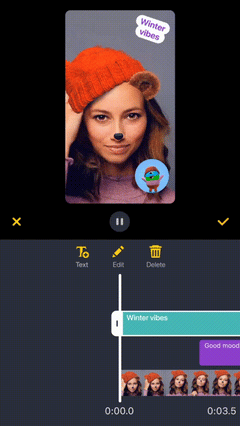
Video editing functionality
These features are at the core of any self-respecting mobile video editor SDK. The important thing here is to strike a balance between the number of features and ease of use.
In the case of short video apps, we are talking about casual content creators, not professional editors. Adding too much complex functionality can turn the users away.
- Video Trimming. Removing the beginning and end portions of the clip or increasing their length. This is the basic editing option that makes it possible to crop clips to the necessary length. A must for any short video sdk.
- Timelines. A frame-by-frame representation of the video, allowing users to place effects at specific points. Without it, editing becomes nigh-impossible.
- Music. Adding a sound track from the phone storage to the clip. Without it, the clips will be much less engaging.
- Picture-in-picture. Overlaying one video onto another. This is especially useful for reactions, one of the most popular and lucrative formats.
- GIFs. Adding GIF images to clips. Another feature that lets users easily modify their creations for better shareability.
- Text. Placing text over videos. A simple function that is good for captioning, adding comments, etc.

Camera features
These features govern the use of the camera and everything related to it. All SDKs that we cover can record videos but there are extra functions that differ between products. These extras either save time or add more self-expression opportunities that attract users.
- Hands-free mode. Set a timer and start recording once it ends. A must-have feature for solo creators (e.g. dancers who want to record themselves performing).
- Voice recording. Picking up sounds from the inbuilt microphone. Saves time on recording.
- Slideshow. Making a video out of pictures from the gallery or taken at the moment. A good alternative to the common videos and another option for self-expression.

Effects
All kinds of video effects that make ordinary clips fun and crazy. This is where an SDK can really show off the modern advancements in augmented reality. Banuba AI Video Effects SDK, for example, boasts filters and AR masks on par with or better than those of TikTok or Snapchat. They will make clips much more shareable and attract new users to your app by sheer virality.
Another thing to note is that effects are not created equal. Similar AR masks from different vendors can differ in their look and reaction to lighting and gravity.
Moreover, some SDKs (like our own) are optimized to show effects well even on older and low-end devices. Banuba AI Video Editor SDK covers 80% of the smartphones on the market.
Finally, there is a service component to this. Sometimes, you might need custom filters (e.g. country-specific, branded, or otherwise unique). Unlike some of our competitors, we at Banuba can make those for you quickly and for a reasonable price.
- Voice effects. Making users sound like robots, Disney princesses, opera singers, etc. Always fun for memes, pranks, and the like.
- LUTs. Color settings to give the video a different look and feel (e.g. black and white or sepia). It is simple to use but can really add style to the clip.
- Visual effects. Overlays changing the look of the video (VHS, rave, etc.) a solid boost in shareability and creative potential of the clip.
- AR masks. Augmented reality overlays that are placed on people’s faces for comical effect. See apps like Chingari for examples of high-quality masks tailored to the region.
- Beautification. Automatically correcting the user’s face to make them look more attractive. This saves the creators’ time as they don’t have to apply makeup before filming. Moreover, beautification makes clips more shareable, as people are always willing to show off their good looks on social media.
- Background segmentation. Separating the background from the foreground and adding an image there. This can act as a “green screen” replacement or element of style, making the video look as if it was filmed in another country or even in space. Finally, it can also be a time-saver, especially if the creator’s flat isn’t very tidy.
-
AI clipping. Similar to the Autocut feature in TikTok, this feature lets users combine several videos and match them to the beat of the music with AI. It makes creating great content much easier.
-
AI subtitles. Automatic caption generation based on speech recognition. It saves a massive amount of time when making content and increases engagement (most users watch videos in silent mode).
-
Video generation. Using artificial intelligence to create some kind of video content without actually recording any footage. This decreases the workload on the editors and helps create many clips in a small amount of time.

Technical features
The parameters that the users don’t know about but that are important to the developers.

- Android SDK. Android holds a much larger market share, so integrating a short video SDK for Android is a way to gain a larger audience.
- iOS SDK. iOS has a lower market share than Android but iPhone users tend to spend more. Making an iOS app is a way to gain an audience with disposable income.
- Cross-platform framework support. Ability to integrate the mobile video editor SDK in apps built with React Native, Flutter, Xamarin, and other cross-platform frameworks. Such frameworks can significantly decrease the development time but not all of them are a good fit for short video apps. Ionic or PhoneGap, for example, don’t perform well enough for this purpose.
- AR cloud. Ability to download AR effects from the cloud servers, thus decreasing the app size. A single AR mask can take 1-3 MB of space, and including a lot of them in the app package will make it unwieldy and inconvenient. AR cloud lets users download the effects they like whenever they need them.
- User interface. Default UI that is included in the short video editing SDK for iOS and Android. If there isn’t one you will have to create it yourself, which costs time and money.
- Music provider integration. Connection to a service that provides royalty-free music for users’ creations. This makes the people on your app and by extension the app itself safe from copyright claims. The music itself is generated by AI and separated into genres and moods so that the users can always find something that fits their videos. In the case of Meishe SDK and other products without this feature, you have to set up the integration yourself, spending valuable time finding the right one. Banuba AI Video Editor SDK can be connected to Mubert, while VerySDK uses Audionautix.

Commercial aspects
These are the business matters that pertain to each SDK.
- UI convenience. How user-friendly is the interface, on a scale of 1-5. The better your app looks, the better it will retain customers. Pick the SDKs with the most convenient UI for lower churn and quicker growth.
- Documentation. Publicly available instructions from the developers for the users. A well-documented SDK is easy to integrate and customize for your purposes. As the main point of using a third-party solution is to decrease time-to-market, having detailed developer notes is extremely helpful.
- Trial version. Ability to test the video editing SDK before fully committing to purchasing.
Different companies have different approaches to trial.
Banuba AI Video Editor SDK can be tried for free for 14 days.
Meishe SDK doesn’t limit the time of trial but places a watermark on all videos made during the testing period.
Img.ly offers 30 days of free trial for their product.
Rendley has a free plan with a very limited functionality.
Very SDK lets the users test it for 7 days.
Tencent UGSV trial period lasts for 30 days.
Picsart also offers a 30-day free trial.
- DIY integration. The client can integrate the SDK without help from the vendor.
- Support response speed. The time it takes for the company’s technical support to answer an inquiry.

Why Banuba AI Video Editor SDK
There are reasons why this product is used in applications having millions of users, especially in the short video apps category.
- Performance. This mobile video editor SDK is optimized to run smoothly on both top-notch and cheap iOS/Android devices. Thanks to it, companies can bring advanced video editing and AR features to more than 80% of all smartphone users.
- Immersive AR Content. Banuba offers an amazing variety of filters: AR masks, color effects (LUTs), and visual effects. All of them are available to be downloaded on demand using Banuba’s AR Cloud service to decrease the app size. Moreover, you can order custom filters and get them ASAP.
- Data safety. Banuba’s AI Video Editor SDK doesn’t store or collect any personal information so there is no risk of losing sensitive user data.
- All-in-one. The short video SDK is enough for all the features a user needs to create cool and engaging clips.
- Customizability. We can add new video editing features on-demand and ship them to your app.
- Maturity. We have been in the AR and video editing market for more than five years. This means our product was well-tested in real apps and has shown its reliability.
- Easy integration. Thanks to the use of Maven packages and CocoaPods, installing Banuba Video Editor SDK is super-fast, sometimes less than 8 minutes.
- Flutter and React Native compatibility. Using cross-platform frameworks can significantly speed up development. Combining them with a video editing SDK helps cut the time-to-market even more.
- Flexibility. Only choose the features that you need to decrease the app download size and costs.
- AI integration. Features like AI clipping and video generation help users make more content faster and increase engagement. Few other SDKs offer them.
Conclusion
We hope our comparison matrix of the 8 best video editing SDKs will help you choose the right provider.
If you want to start with powerful software, feel free to try Banuba's Video Editor SDK and get a 14-day free trial.




